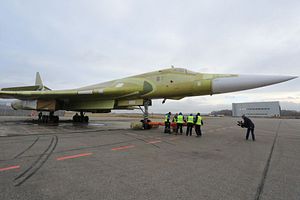The Russian Aerospace Force’s entire fleet of new Tupolev Tu-160M2 long-range supersonic strategic bombers are expected to be put into service by 2030, according to Russian Deputy Defense Minister Yuri Borisov.
“We are going to purchase the entire fleet of our strategic Tu-160 bombers in their new version and carry out heavy upgrade[s] of operational aircraft where only the fuselage will remain while all the onboard radio-electronic equipment and engines will be replaced,” Borisov said on March 21, TASS news agency reports. “That is why, we will get the renewed fleet of strategic aircraft somewhere by 2030.”
It is unclear whether Borisov in his comments was referring to the existing stockpile of 16 Tu-160s or the 50 Tu-160M2s purportedly to be manufactured at a rate of three aircraft per year beginning in 2023. The Russian Ministry of Defense (MoD) announced in January, that it had placed an order for the first batch of 10 Tupolev Tu-160M2s with the bomber’s manufacturer, United Aircraft Corporation (UAC).
The day the order for the 10 aircraft, estimated to be worth around $2.7 billion, was placed coincided with the maiden flight of the first partially upgraded Tu-160M2. (The Tu-160M2 flew with an old engine.) The aircraft was first rolled out at the S.P. Grobunov assembly facility in Kazan in southwest Russia in November 2017. The new Tu-160M2 will be an upgraded variant of the Cold War-era Soviet Tu-160, first introduced into service in 1987 and the last strategic bomber to enter service prior to the collapse of the Soviet Union.
Next to upgraded avionics and a new engine, the aircraft will also feature “special coatings,” according to Borisov, to reduce the plane’s radar signature. The new bomber will be be armed with long-range standoff cruise missiles, including the Kh-101/Kh-102 (nuclear variant) air-launched cruise missile and the Kh-55 subsonic air-launched cruise missile, among others.
As with other aircraft programs such as the Su-57 stealth fighter, the Russian military aircraft industry has been struggling to develop a next-generation engine for the bomber, as I reported in January:
[The] Russian military aircraft industry still is having trouble with the bomber’s new engine. (…) The Tu-160M2 is expected to be fitted with the new Kuznetsov NK-32-2 turbofan engine, providing increased maneuverability and range.
(…) The Russian aircraft industry began testing a non-afterburning variant of the Kuznetsov NK-32 engine, purportedly the largest and most powerful turbofan jet engine ever fitted on a bomber, in October [2017]. The new engine will reportedly increase the new bomber’s operational range by up to 1,000 kilometers.
Borisov, on March 21, noted that the new engine will increase fuel efficiency by 10 percent: “In its upgraded version, it [the engine] will be 10 percent more efficient, which will make it possible to increase the flight range of the strategic bomber by about 1,000 kilometers.” As of now, it is unclear when the new engine will be ready for serial production.































